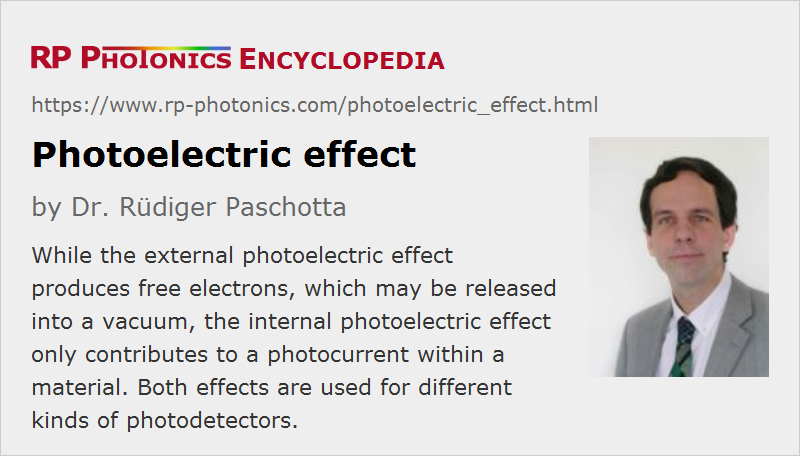Photoelectric Effect
Definition: the emission or excitation of electric carriers related to the absorption of light
Alternative term: photoemission
German: photoelektrischer Effekt
Categories: light detection and characterization, physical foundations
How to cite the article; suggest additional literature
Author: Dr. Rüdiger Paschotta
The operation principles of many types of photodetectors – e.g. photodiodes, phototransistors, phototubes and CCD or CMOS image sensors – are based on the photoelectric effect. This actually comes in two quite different forms: the external and internal photoelectric effect.
External Photoelectric Effect
If light with a sufficiently high photon energy (above the so-called work function) hits a metal (or semiconductor) surface, for example, some of the light may be absorbed, and electrons are emitted from the surface. If the metal part (called a photocathode) is kept in vacuum and an electric field is applied using a second electrode (the anode), which attracts those electrons, one can detect a photocurrent, which is proportional to the incident light intensity. The external photoelectric effect provides the working principle of a vacuum phototube. Here, external means that the electrons are obtained outside the material from which they have been released.
That form of photoelectric effect, discovered in the late 19th century, found substantial attention by Philipp Lenard, Albert Einstein and others in the early 20th century. It had been observed that the photoelectric effect occurs only for light with wavelengths below a certain limit, depending on the material; for longer wavelengths, even rather high optical intensities cannot give rise to that effect. Also, Lenard noticed that the maximum energy of photoelectrons (measured via a required stopping potential) was independent on the light intensity, contrary to expectations. Instead, that maximum energy depends on the optical wavelength: the shorter the wavelength, the higher the photoelectron energy, while the light intensity only affects the rate of photoelectrons emission. Those observations, which were hard to reconcile with classical electromagnetic theory, led to the idea that light energy is delivered in the form of small packages, which have later been named photons. They thus contributed to the early development of quantum mechanics and quantum optics.
The photon model well explains the mentioned observations. Only if a photon has a sufficiently high energy, it can trigger the emission of a photoelectrons – a process which requires a certain energy, namely the binding energy plus the resulting kinetic energy of the electron. A more detailed explanation involves solid-state physics with features like energy bands and Fermi energy.
The external photoelectric effect is utilized in vacuum tube photodetectors, in particular in phototubes and photomultiplier tubes, but also in infrared viewers, streak cameras, image intensifiers (image amplifiers) and image converters. Besides, pulsed photocathodes, which are illuminated with ultrashort laser pulses, are used in some particle accelerators.
Internal Photoelectric Effect
The internal photoelectric effect does not produce photoelectrons which are observable outside the material, but only excites electrons to higher levels, namely from the valence band to the conduction band in a semiconductor material. A consequence of that is that a photocurrent is usually detected in a reverse-biased p–n junction or p–i–n junction. For explanations on the latter case, see the article on p–i–n photodiodes. There are also metal–semiconductor–metal photodetectors, where a Schottky junction is used.
The internal photoelectric effect is exploited in various types of semiconductor photodetectors, namely in photodiodes and phototransistors. Its precondition is that the photon energy is larger than the band gap energy of the material in the active region. While the bandgap energy of typical dielectrics like silica or other optical glasses is substantially too large, and also the carrier lifetime would be too short, various semiconductors exhibit a suitably small bandgap energy. For example, silicon-based detectors can work with wavelengths up to roughly 1.1 μm, although the responsivity often drops substantially above 1 μm. Materials with still lower bandgap energy allow photodetection at longer wavelengths – for example, indium gallium arsenide (InGaAs) up to ≈1.7 μm.
There are even materials for the detection of mid-infrared light, e.g. in infrared cameras. Their bandgap energy is so small that substantial thermal excitation occurs already at room temperature. To avoid that, such detectors need to be operated at substantially lower temperatures, e.g. using a Stirling cooler.
Questions and Comments from Users
Here you can submit questions and comments. As far as they get accepted by the author, they will appear above this paragraph together with the author’s answer. The author will decide on acceptance based on certain criteria. Essentially, the issue must be of sufficiently broad interest.
Please do not enter personal data here; we would otherwise delete it soon. (See also our privacy declaration.) If you wish to receive personal feedback or consultancy from the author, please contact him e.g. via e-mail.
By submitting the information, you give your consent to the potential publication of your inputs on our website according to our rules. (If you later retract your consent, we will delete those inputs.) As your inputs are first reviewed by the author, they may be published with some delay.
See also: photocathodes, photodetectors, photodiodes, phototransistors, phototubes, image sensors
and other articles in the categories light detection and characterization, physical foundations
 |




If you like this page, please share the link with your friends and colleagues, e.g. via social media:
These sharing buttons are implemented in a privacy-friendly way!